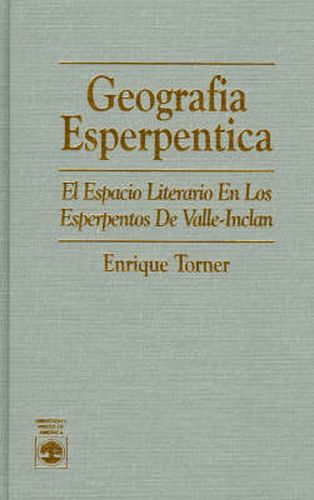Readings Newsletter
Become a Readings Member to make your shopping experience even easier.
Sign in or sign up for free!
You’re not far away from qualifying for FREE standard shipping within Australia
You’ve qualified for FREE standard shipping within Australia
The cart is loading…






This book is the first work devoted to a comprehensive study of literary space in the works of Valle- Inclan. The author looks at Valle- Inclan’s esperpentos from a semiotic perspective. He explains the symbolism of the writer’s locations and of other pertinent esperpentic patterns. Torner argues that literary space is fundamental for the structuring of the esperpentos and for most of Valle- Inclan’s works. Written in Spanish, the book is comprised of five chapters. The first one offers the basis of the analysis, describing the structure of the esperpentos and other pertinent works and showing their mathematical pattern. The second chapter is devoted to the different structuring levels of Luces de bohemia. The third chapter is a comprehensive study of the different locations represented in Valle- Inclan’s esperpentos. These locations are classified within five major categories: the house, natural backgrounds (the garden, aquatic places, the cave and the moon), travel routes and means, and religious and entertainment locations. An in-depth study of these locations is done here in their context. The fourth chapter studies the real geographic places described and referred to in his esperpentos (Galicia, Madrid, Andalucia, Mexico/Spanish America and the undefined location). The final chapter analyzes the method used for describing space in the dramatic works and the novels. The conclusions bear out how the whole of Valle- Inclan’s esperpentos reflect a deep interest in constructing a coherent literary world in which intertextual references play an important role. This important work will be valuable reading for courses on Spanish literature and for seminars on Generacion del 98 or on Valle- Inclan. Anyone interested in Valle- Inclan will surely want a copy of this unique study and interpretation of his works.
$9.00 standard shipping within Australia
FREE standard shipping within Australia for orders over $100.00
Express & International shipping calculated at checkout
This book is the first work devoted to a comprehensive study of literary space in the works of Valle- Inclan. The author looks at Valle- Inclan’s esperpentos from a semiotic perspective. He explains the symbolism of the writer’s locations and of other pertinent esperpentic patterns. Torner argues that literary space is fundamental for the structuring of the esperpentos and for most of Valle- Inclan’s works. Written in Spanish, the book is comprised of five chapters. The first one offers the basis of the analysis, describing the structure of the esperpentos and other pertinent works and showing their mathematical pattern. The second chapter is devoted to the different structuring levels of Luces de bohemia. The third chapter is a comprehensive study of the different locations represented in Valle- Inclan’s esperpentos. These locations are classified within five major categories: the house, natural backgrounds (the garden, aquatic places, the cave and the moon), travel routes and means, and religious and entertainment locations. An in-depth study of these locations is done here in their context. The fourth chapter studies the real geographic places described and referred to in his esperpentos (Galicia, Madrid, Andalucia, Mexico/Spanish America and the undefined location). The final chapter analyzes the method used for describing space in the dramatic works and the novels. The conclusions bear out how the whole of Valle- Inclan’s esperpentos reflect a deep interest in constructing a coherent literary world in which intertextual references play an important role. This important work will be valuable reading for courses on Spanish literature and for seminars on Generacion del 98 or on Valle- Inclan. Anyone interested in Valle- Inclan will surely want a copy of this unique study and interpretation of his works.